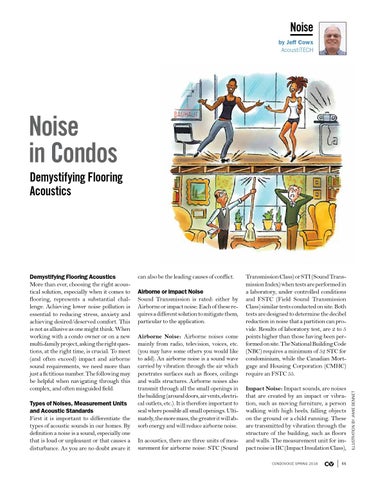Noise by Jeff Cowx AcoustiTECH
Noise in Condos Demystifying Flooring Acoustics
Types of Noises, Measurement Units and Acoustic Standards First it is important to differentiate the types of acoustic sounds in our homes. By definition a noise is a sound, especially one that is loud or unpleasant or that causes a disturbance. As you are no doubt aware it
can also be the leading causes of conflict. Airborne or impact Noise Sound Transmission is rated: either by Airborne or impact noise. Each of these requires a different solution to mitigate them, particular to the application. Airborne Noise: Airborne noises come mainly from radio, television, voices, etc. (you may have some others you would like to add). An airborne noise is a sound wave carried by vibration through the air which penetrates surfaces such as floors, ceilings and walls structures. Airborne noises also transmit through all the small openings in the building (around doors, air vents, electrical outlets, etc.). It is therefore important to seal where possible all small openings. Ultimately, the more mass, the greater it will absorb energy and will reduce airborne noise. In acoustics, there are three units of measurement for airborne noise: STC (Sound
Transmission Class) or STI (Sound Transmission Index) when tests are performed in a laboratory, under controlled conditions and FSTC (Field Sound Transmission Class) similar tests conducted on site. Both tests are designed to determine the decibel reduction in noise that a partition can provide. Results of laboratory test, are 2 to 5 points higher than those having been performed on site. The National Building Code (NBC) requires a minimum of 52 STC for condominium, while the Canadian Mortgage and Housing Corporation (CMHC) require an FSTC 55. Impact Noise: Impact sounds, are noises that are created by an impact or vibration, such as moving furniture, a person walking with high heels, falling objects on the ground or a child running. These are transmitted by vibration through the structure of the building, such as floors and walls. The measurement unit for impact noise is IIC (Impact Insulation Class), CONDOVOICE SPRING 2016
CV
55
ILLUSTRATION BY JAMIE BENNET
Demystifying Flooring Acoustics More than ever, choosing the right acoustical solution, especially when it comes to flooring, represents a substantial challenge. Achieving lower noise pollution is essential to reducing stress, anxiety and achieving desired/deserved comfort. This is not as allusive as one might think. When working with a condo owner or on a new multi-family project, asking the right questions, at the right time, is crucial. To meet (and often exceed) impact and airborne sound requirements, we need more than just a fictitious number. The following may be helpful when navigating through this complex, and often misguided field.
